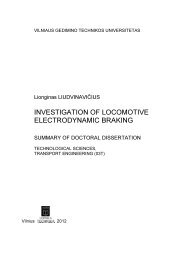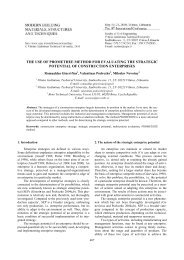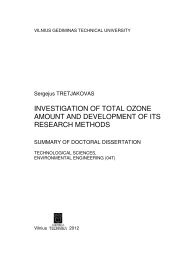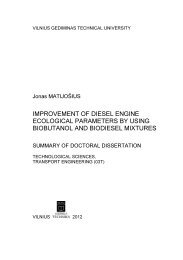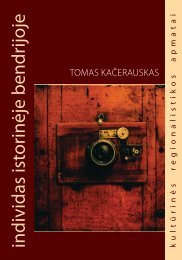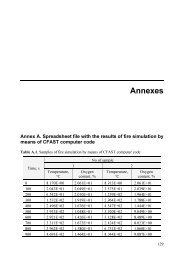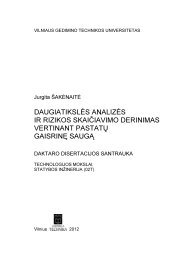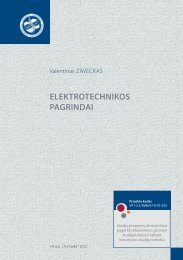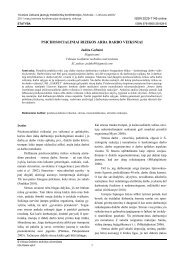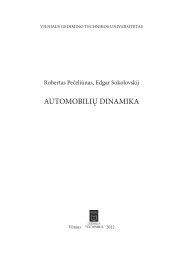electromagnetic radiation of mobile communication investigation ...
electromagnetic radiation of mobile communication investigation ...
electromagnetic radiation of mobile communication investigation ...
You also want an ePaper? Increase the reach of your titles
YUMPU automatically turns print PDFs into web optimized ePapers that Google loves.
IntroductionTopicality <strong>of</strong> the problemThe world we live in is constantly modernizing and the <strong>electromagnetic</strong><strong>radiation</strong> emitted by electronic devices, electric-power transmissions, televisionand radio stations, computers, radars, <strong>mobile</strong> phone antennas and, especially, by<strong>mobile</strong> phones constantly affect people and can cause various health problems.Electromagnetic waves surround us, however, we are not capable to smell, seeor feel them.In the twenty-first century, with the spread <strong>of</strong> <strong>mobile</strong> phone networks andintroduction <strong>of</strong> GSM-900, GSM-1800, UMTS-2100 systems, the number <strong>of</strong>sources <strong>of</strong> <strong>electromagnetic</strong> <strong>radiation</strong> increased. A lot <strong>of</strong> people use <strong>mobile</strong>connection without concerning its operating principles: something that is notseen can cause harm. Active use <strong>of</strong> <strong>mobile</strong> phones and their level temporaldynamics allow perceiving the component <strong>of</strong> <strong>electromagnetic</strong> background asone <strong>of</strong> the most important physical agents that actively affect live organismsand environment.Due to the growing number and scope <strong>of</strong> sources <strong>of</strong> <strong>electromagnetic</strong><strong>radiation</strong> from <strong>mobile</strong> phones, their effect became significant not only forspecialist but for all the inhabitants <strong>of</strong> surrounding areas. In some countries<strong>mobile</strong>-free zones are demanded. In such zones it is forbidden to install <strong>mobile</strong><strong>communication</strong> base stations, it is also required to reduce the highest levels <strong>of</strong>allowed <strong>electromagnetic</strong> <strong>radiation</strong> or other restrictions are imposed.When the <strong>mobile</strong> phone is used, it is put to the ear, and when not – itusually stays in the pocket, near the body, in this way the <strong>electromagnetic</strong><strong>radiation</strong> emitted by (ringing) <strong>mobile</strong> phone directly interacts with human body.Common <strong>mobile</strong> phone cases do not provide protection from <strong>electromagnetic</strong><strong>radiation</strong>. Therefore, cases that would protect from <strong>electromagnetic</strong> <strong>radiation</strong>,when using <strong>mobile</strong> phones, and that would not have negative effect on thequality <strong>of</strong> connection, are necessary.Measurements and evaluation <strong>of</strong> <strong>electromagnetic</strong> <strong>radiation</strong> level, reduction<strong>of</strong> the highest allowed level <strong>of</strong> <strong>electromagnetic</strong> <strong>radiation</strong> and establishment <strong>of</strong>other regulations – are issues <strong>of</strong> world-wide importance. At the moment, themost important concern is the contradictory information about <strong>mobile</strong> phonesand <strong>mobile</strong> <strong>communication</strong> base stations, and their declared effects on humanhealth.The Ministry <strong>of</strong> Health informs that on 31 st May 2011 the World HealthOrganisation’s International Agency for Research on Cancer announced that,when the <strong>mobile</strong> phone is used for a long time – 30 or more minutes per day,the radi<strong>of</strong>requency <strong>electromagnetic</strong> fields can increase risks <strong>of</strong> the brain5
tumour. World Health Organisation stresses that when <strong>mobile</strong> phone is usedproperly and following all safety measures the negative effects on health causedby <strong>electromagnetic</strong> <strong>radiation</strong> can be minimised or avoided.Due to the lack <strong>of</strong> scientific researches on <strong>electromagnetic</strong> <strong>radiation</strong> from<strong>mobile</strong> phones and public concern, the tendencies <strong>of</strong> EMF insensitivityparameters in the environment are discussed in this thesis. The contemporaryopinion on the negative effect <strong>of</strong> <strong>mobile</strong> phone antennas and <strong>electromagnetic</strong><strong>radiation</strong> from <strong>mobile</strong> phones does not allow making assumptions about futureconsequences. Thus, on the basis <strong>of</strong> conducted scientific research, not onlypractical but also engineering – technical safety measures from <strong>electromagnetic</strong><strong>radiation</strong> have been provided in this thesis.A rapid increase in the level <strong>of</strong> <strong>electromagnetic</strong> <strong>radiation</strong> (many timesexceeding original background) that can damage ecological balance <strong>of</strong> theenvironment has been observed; therefore, it should be researched andevaluated by theoretical and experimental methods.Object <strong>of</strong> the work – the <strong>electromagnetic</strong> <strong>radiation</strong> emitted by <strong>mobile</strong>connection antennas and <strong>mobile</strong> phones.Aim and tasks <strong>of</strong> the workThe aim <strong>of</strong> this thesis is to research and evaluate the spread <strong>of</strong><strong>electromagnetic</strong> <strong>radiation</strong> emitted by <strong>mobile</strong> connection antennas and <strong>mobile</strong>phones.To reach the aim set in the thesis, it is necessary to tackle the followingtasks:1. To evaluate the spread <strong>of</strong> <strong>electromagnetic</strong> <strong>radiation</strong>, created by the antennaswith different overall effective radiated power in the environment.2. To research the strength <strong>of</strong> electric field created by the various <strong>mobile</strong>phone models.3. To create the strength spread <strong>of</strong> electric fields <strong>of</strong> <strong>mobile</strong> phones aroundhead; and provide the evaluation <strong>of</strong> <strong>electromagnetic</strong> <strong>radiation</strong> strength <strong>of</strong><strong>mobile</strong> phone antennas by applying theoretical research.4. To investigate materials that screen <strong>electromagnetic</strong> <strong>radiation</strong>, and to create<strong>mobile</strong> phone case that reduces the <strong>electromagnetic</strong> <strong>radiation</strong>.Methodology <strong>of</strong> research. In this thesis the methodologies <strong>of</strong> researcheson <strong>electromagnetic</strong> <strong>radiation</strong> emitted by the <strong>mobile</strong> connection antennas and<strong>mobile</strong> phones are applied according to the requirements <strong>of</strong> hygiene norms andISO standards. The researches on the materials that screen <strong>electromagnetic</strong><strong>radiation</strong> are conducted according to research conducting methodologies6
provided in the IEEE standards. The empirical formulas have been used for themodel <strong>investigation</strong>s <strong>of</strong> <strong>electromagnetic</strong> <strong>radiation</strong> level <strong>of</strong> <strong>mobile</strong> phoneantennas. “COMSOL Multiphysics” s<strong>of</strong>tware was used to establish spread <strong>of</strong>electric fields strength created by <strong>mobile</strong> phones around head.Scientific novelty <strong>of</strong> the work. Complex experimental studies <strong>of</strong> <strong>mobile</strong>connection antennas (<strong>of</strong> low, medium and high effective <strong>radiation</strong> power) and<strong>mobile</strong> phones (GSM second generation (2G) and UMTS third generation(3G)). Simulations carried out by employing two different modellingmethodologies (“COMSOL Multiphysics” applied for <strong>mobile</strong> phone<strong>electromagnetic</strong> field strength modelling, and simulation researches – forassessment and visualization <strong>of</strong> <strong>mobile</strong> connection antennas’ <strong>electromagnetic</strong><strong>radiation</strong> according to the acquired results). Scientific novelty <strong>of</strong> the work inscientific field <strong>of</strong> Environmental engineering is created <strong>mobile</strong> phone case thatprotects from <strong>electromagnetic</strong> <strong>radiation</strong>.Practical value. According to the results <strong>of</strong> the research, it is possible torenew the legal regulatory framework <strong>of</strong> <strong>electromagnetic</strong> expertise, thatregulates the allowed intensity level <strong>of</strong> the <strong>electromagnetic</strong> fields, and toimprove evaluation methods and methodologies for <strong>electromagnetic</strong> <strong>radiation</strong>.Considering the gathered results in the analysis <strong>of</strong> <strong>electromagnetic</strong> <strong>radiation</strong> <strong>of</strong><strong>mobile</strong> phones it is possible to provide recommendations for <strong>mobile</strong> phonesafety. The <strong>mobile</strong> phone case that reduces the <strong>electromagnetic</strong> <strong>radiation</strong> <strong>of</strong><strong>mobile</strong> phone, for which the patent application has been filed, has been created.The field research methodology can be further used for the evaluation <strong>of</strong> theepidemiologic state <strong>of</strong> a certain area.Defended propositions1. Mobile connection antennas’ <strong>electromagnetic</strong> field energy flux densityvalues in ground-level air increase further from the antenna, highest valuescan be observed at the point where main antenna <strong>radiation</strong> zone reachesearth surface, further on, it declines.2. The strength <strong>of</strong> electric field is directly proportional to the transmissionpower <strong>of</strong> a <strong>mobile</strong> phone and is inversely proportional to frequency anddepends on the space, whether it is closed or open.3. Strength <strong>of</strong> a <strong>mobile</strong> phone electric field on the head decreasesexponentially while moving sideward from the epicentre <strong>of</strong> the effect zone,and depends on density <strong>of</strong> constituent parts <strong>of</strong> the head.7
The scope <strong>of</strong> the scientific work. The thesis consists <strong>of</strong> introduction, threebody chapters, discussion <strong>of</strong> results, general conclusions and recommendations.Scope <strong>of</strong> the thesis is 155 pages, 22 numbered formulas, 85 figures and14 tables. The list <strong>of</strong> references consists <strong>of</strong> 107 sources.1. Mobile tele<strong>communication</strong> <strong>electromagnetic</strong> <strong>radiation</strong> analysisDuring the last two decades the number <strong>of</strong> <strong>mobile</strong> phone antennas thatemit <strong>electromagnetic</strong> <strong>radiation</strong> in the living areas increased significantly,therefore much more attention is paid to the <strong>electromagnetic</strong> <strong>radiation</strong> and itseffects on human body. The irradiance <strong>of</strong> <strong>electromagnetic</strong> <strong>radiation</strong> is not asdangerous as ionizing <strong>radiation</strong>, but its effects on live organism are differentand effect more people, therefore, the effects <strong>of</strong> <strong>electromagnetic</strong> <strong>radiation</strong> onhuman beings is becoming more relevant.The distribution <strong>of</strong> <strong>electromagnetic</strong> <strong>radiation</strong> <strong>of</strong> <strong>mobile</strong> phone antennaslargely depends on the electrical and mechanic tilt angles in antenna directionaldiagrams. When the antenna directional diagrams are chosen precisely in thevertical and horizontal planes, with different electrical tilt angles, it assures thatmeasured real parameter values <strong>of</strong> <strong>electromagnetic</strong> insensitivity created byantennas at any point in the plane will not be higher than forecasted and willcorrespond to the requirements <strong>of</strong> hygiene norms that regulate sources <strong>of</strong>nonionizing <strong>radiation</strong>.One <strong>of</strong> the most actively used sources <strong>of</strong> <strong>electromagnetic</strong> <strong>radiation</strong> is the<strong>mobile</strong> phone. Mobile phone is a small compact transmitter and receiver in asingle casing. The owner always carries <strong>mobile</strong> phone nearby; therefore it haseffects on the owner. While talking on the phone, the <strong>electromagnetic</strong> field isdirectly pointed towards the brain. During the conversation each <strong>mobile</strong> phoneemits different strengths <strong>of</strong> electric field.Significant scientific researches on <strong>electromagnetic</strong> <strong>radiation</strong> have beenconducted by a number <strong>of</strong> scholars: S. Allen, H. Bassen, G. D´Inzeo, A. Hirata,K. Jokela, J. Lin, S. Mann, R. Matthes, C. Roy, M. Taki, J. Wang, S. Watanabe.They researched the <strong>electromagnetic</strong> <strong>radiation</strong> effects on health and relationbetween <strong>electromagnetic</strong> <strong>radiation</strong> and oncological illnesses. Such scholars asU. Bergqvist, G. Friedrich, Y. Hamnerius, L. Martens, G. Neubauer, G.Thuroczy, E. Vogel, J. Wiart conducted researches on <strong>electromagnetic</strong> <strong>radiation</strong><strong>of</strong> <strong>mobile</strong> <strong>communication</strong> base stations in Switzerland. The researches wereconducted in inhabitant areas by identifying the sources <strong>of</strong> <strong>electromagnetic</strong><strong>radiation</strong>. K. Y. Nikolaevich, A. V. Nikolaevich, K. V. Anatolievich, W. P.Thompson, O. H. Peter invented protective screen from <strong>electromagnetic</strong><strong>radiation</strong>. The scholars from VGTU Department <strong>of</strong> Tele<strong>communication</strong>8
Engineering R. Pocius, A. Anskaitis, D. Guršnys, K. Mikėnas and G. Montvilasare conducting model <strong>investigation</strong>s on <strong>electromagnetic</strong> <strong>radiation</strong> intensivityparameters in the base station environment.2. Mobile tele<strong>communication</strong> <strong>electromagnetic</strong> <strong>radiation</strong> researchmethodologyWhile conducting field researches on <strong>electromagnetic</strong> <strong>radiation</strong> it is veryimportant to foresee and evaluate the areas <strong>of</strong> research. One <strong>of</strong> the mostimportant parts is to evaluate where values <strong>of</strong> <strong>electromagnetic</strong> <strong>radiation</strong> will behighest i.e. to determine the most intense <strong>radiation</strong> direction <strong>of</strong> each antenna.This is done in two steps: by analysing technical characteristics <strong>of</strong> <strong>mobile</strong>phone antennas and conducting control researches in the researchedenvironment. In order to evaluate the most intense <strong>radiation</strong> direction, all <strong>of</strong> theantenna directional diagrams in vertical and horizontal planes are used. All<strong>mobile</strong> phone antenna manufacturers provide antenna <strong>radiation</strong> diagrams withtechnical characteristics in catalogues.The most important criteria for the choice <strong>of</strong> researches on <strong>electromagnetic</strong><strong>radiation</strong> <strong>of</strong> <strong>mobile</strong> phone antennas: overall effective radiated power (ERP),height <strong>of</strong> antenna and specific research points (the researches are conducted inliving areas, towards the most intensive direction <strong>of</strong> <strong>mobile</strong> connection antenna,on the ro<strong>of</strong>s with <strong>mobile</strong> phone connection and in the areas, towards the mostintensive direction <strong>of</strong> <strong>mobile</strong> phone antenna, where people have free access).Models <strong>of</strong> <strong>mobile</strong> connection antennas used in Lithuania have been chosenfor the research. The <strong>mobile</strong> phone antennas are divided into 3 groupsaccording to the different effective radiated power <strong>of</strong> <strong>mobile</strong> connectionantennas: antennas <strong>of</strong> low (i. e. 193 W, 281 W and 305 W), medium – (i. e. 484W, 707 W and 966 W) and high – (i. e. 1329 W, 1428 W and 1739 W) effectiveradiated strength. In each group 3 <strong>mobile</strong> connection antennas <strong>of</strong> differentheight are chosen for the research: short antennas (i. e. 14 m, 21.5 m and 25 m),medium – (i. e. 30 m and 50 m) and high (75 m). Three antennas have been puton top <strong>of</strong> the building and 4 on special towers. According to the radiatedfrequency <strong>mobile</strong> connection antennas are divided into 3 technologies: GSM900, GSM 1800 and UMTS 2100. GSM standard for <strong>mobile</strong> connection is thesecond generation (2G) European standard for <strong>mobile</strong> connection, in whichfrequency range is 900 MHz (GSM-900) and 1800 MHz (GSM-1800). UMTSstandard for <strong>mobile</strong> connection is the third generation (3G) <strong>mobile</strong> connectiontechnology, in which frequency range 2100 MHz (UMTS-2100) is used.In the close distance area i. e. closer than 30 m from the antenna (in bothhorizontal and vertical planes) the strengths <strong>of</strong> electric and magnetic fields are9
measured. In the far distance areas i.e. further than 30 m (in both horizontal andvertical planes) energy flux density <strong>of</strong> <strong>electromagnetic</strong> field is measured fromthe antenna. If the <strong>mobile</strong> connection antenna is mounted on the building ormast that is higher than 30 m, the energy flux density <strong>of</strong> <strong>electromagnetic</strong> field ismeasured on the ground.Electric and magnetic field strengths are measured in the distance <strong>of</strong> – 1 m,5 m, 10 m, 15 m, 20 m, 25 m and 30 m in the close distance area (closer than30 m), on the ro<strong>of</strong>, towards the most intensive direction <strong>of</strong> <strong>mobile</strong> phoneantenna. The researches are conducted 1.5 m above the ro<strong>of</strong> <strong>of</strong> the building withmounted antenna. The energy flux density <strong>of</strong> <strong>electromagnetic</strong> field is measuredin 10 m distance from <strong>mobile</strong> connection antenna. The radius <strong>of</strong> the research is500 m. The result <strong>of</strong> the research is the arithmetic average <strong>of</strong> 3 values. Theduration <strong>of</strong> one measurement is 6 minutes.The researches on electric field strength <strong>of</strong> <strong>mobile</strong> phones are conducted:in open space, when sending and receiving antennas are in the zone <strong>of</strong> directvisibility; in closed space when sending and receiving antennas are not in thezone <strong>of</strong> direct visibility and have obstacles (building walls); in non-stationaryspace (when driving a car). The aim is to investigate the electric field strengthcreated by various <strong>mobile</strong> phones models under different conditions. Theresearches are conducted by using GSM second generation (2G) <strong>mobile</strong> phonesthat operate within frequency range from 900 MHz to 1800 MHz and by UMTSthird generation (3G) smart <strong>mobile</strong> phones that operate in 2100 MHz frequencyrange. The main criteria in the choice <strong>of</strong> <strong>mobile</strong> phones were differences inSAR and power. The most popular GSM 900 <strong>mobile</strong> phones consume two types<strong>of</strong> power: high maximum power transfer i. e. up to 2 W and medium – up to0.8 W. GSM 1800 consumes medium – up to 1 W and low – up to 0.25 Wpower. Mobile phones UMTS consumes 4 types <strong>of</strong> power: high which is up to –2 W, medium – up to 0.5 W, 0.25 W and low – up to 0.125 W. The<strong>electromagnetic</strong> measuring device is put in front <strong>of</strong> the <strong>mobile</strong> phone; theelectric field strength is measured during conversation.The “COMSOL Multiphysics” s<strong>of</strong>tware allows to model the spread <strong>of</strong><strong>electromagnetic</strong> fields in head, when the <strong>mobile</strong> phone is used . The aim <strong>of</strong>modelling is to evaluate distribution <strong>of</strong> electric field strength created bydifferent <strong>mobile</strong> phones on the surface <strong>of</strong> head.The theoretical modelling <strong>of</strong> energy flux density spread <strong>of</strong> <strong>electromagnetic</strong>field is done by applying physical peculiarities <strong>of</strong> <strong>electromagnetic</strong> waves<strong>radiation</strong>. The aim <strong>of</strong> modelling is to evaluate the energy flux densitydistribution <strong>of</strong> <strong>electromagnetic</strong> field from <strong>mobile</strong> phone antennas. After theevaluation <strong>of</strong> modelling researches, the visual representation <strong>of</strong> <strong>electromagnetic</strong>10
adiation spread is carried out according to the results by using AutoCadprogram package.The methodology <strong>of</strong> researches on materials that screen <strong>electromagnetic</strong><strong>radiation</strong> is provided. Electromagnetic field measuring device NBM 550 is putin 30 cm distance from the material that is being researched. On the oppositeside in 30 cm distance from the material that is being researched the antenna <strong>of</strong><strong>electromagnetic</strong> field generator is set. The antenna <strong>of</strong> <strong>electromagnetic</strong> fieldgenerator is constantly emitting <strong>electromagnetic</strong> field energy density <strong>of</strong> 10µW/cm².In order to reduce the <strong>electromagnetic</strong> <strong>radiation</strong>, the following materialsare investigated: metal netting, aluminized foil, tin, brass sheet, steel sheet,aluminium sheet, concrete, rubber, plasterboard, wooden sheet. Various types<strong>of</strong> glass have been used as well.3. Mobile tele<strong>communication</strong> <strong>electromagnetic</strong> <strong>radiation</strong> experimentalresearch resultsThe researches on directional <strong>mobile</strong> connection antenna (ERP = 1739 W)conducted in 14 m height above ground revealed that electric and magneticfields’ strength quickly diminishes when the distance from antenna increases.Evident decrease in electric field strength is noticed in 15 metres distance from<strong>mobile</strong> connection antenna, then its values are reduced twice, from 20 V/m to11.4 V/m. When the distance from antenna increases, 20 meters or more, theelectric field strength is not so evident and changes are within the range <strong>of</strong> 10.5V/m to 7.5 V/m. The changing <strong>mobile</strong> phone electric field creates magneticfield, therefore, the magnetic field strength tendencies to diminish are similar tothe electric field’s. In the distance from 1 meter to 15 meters the magnetic fieldstrength is reduced by 0.6 time and changed within the range <strong>of</strong> 0.05 A/m to0.03 A/m. When the distance from <strong>mobile</strong> phone antenna increases, themagnetic field strength diminished evenly and changed within the range <strong>of</strong>0.028 A/m to 0.02 A/m.In the far distance area (more than 20 m distance) the <strong>electromagnetic</strong> fieldhas formed into <strong>electromagnetic</strong> wave: the spread directions <strong>of</strong> electric andmagnetic field strengths are perpendicular to each other; the ratio <strong>of</strong> electric andmagnetic field strengths is constant and equal to 377. In the far distance area theenergy flux density <strong>of</strong> <strong>electromagnetic</strong> field is measured.The <strong>mobile</strong> connection antenna (ERP = 1739 W, height 14 m) EMF energyflux density dependence on the distance <strong>of</strong> 1.5 m above the ground is shown inthe Figure 1.11
Energy flux density, µW/cm² ...1010,10,0130 40 50 60 70 80 90 100 200 300 400 500Distance, mThe <strong>mobile</strong> antenna EMF<strong>radiation</strong>Total EMF <strong>radiation</strong>Fig. 1. Dependence <strong>of</strong> <strong>mobile</strong> connection antenna (ERP = 1739 W, height 14 m) EMFenergy flux density distribution from distance, if the height is 1,5 m above the groundlevelFrom Figure 1, reveals that directional <strong>mobile</strong> connection antenna (ERP =1739 W, height 14 m) towards the most intensive direction <strong>of</strong> <strong>radiation</strong>, 1.5 mabove ground in 50 m distance, creates the local maximum <strong>of</strong> EMF energy fluxdensity (0.98 µW/cm²). In greater than 50 m distance, EMF energy flux densitystarts to decrease: in 60 metres distance reaches 0.74 µW/cm², in 70 m –0.15 µW/cm², in 80 m – 0.13 µW/cm², in 90 – 0.11 µW/cm², in 100 m –0.1 µW/cm². In greater than 100 m distance energy flux density <strong>of</strong><strong>electromagnetic</strong> field changes marginally and is scattered within the range <strong>of</strong>0.05 µW/cm² to 0.1 µW/cm². The <strong>investigation</strong>s <strong>of</strong> the research revealed thatantenna diagram in the vertical plane has a narrow <strong>radiation</strong> lobe <strong>of</strong> 6.8º<strong>radiation</strong> width which is directed downwards with the help <strong>of</strong> mechanical andelectrical tilt. Therefore, the highest energy flux density is registered where themain antenna diagram lobe reaches ground level (in this case in 50 m distancefrom antenna). It is obvious that the maximum created by <strong>mobile</strong> phone antennadepends on the ERP <strong>of</strong> the antenna and height above the ground level <strong>of</strong> theantenna. The <strong>mobile</strong> connection antenna in the maximum <strong>radiation</strong> directioncreates one maximum. Mobile connection antennas <strong>electromagnetic</strong> fieldenergy flux density values in ground-level air increase further from the antenna,highest values can be observed at the point where main antenna <strong>radiation</strong> zonereaches earth surface, further on, it declines.12
The Figure 3 displays the distribution <strong>of</strong> <strong>mobile</strong> phone electric fieldstrength during the conversation over a <strong>mobile</strong> phone, which SAR is 0.57 W/kg,maximum power 0.125 W, used frequency 2100 MHz, the level <strong>of</strong><strong>electromagnetic</strong> signal in the environment (–70 dBm). The received results(Figure 3) reveal that the electric field strength created by <strong>mobile</strong> phone (colourred) reaches 1 V/m around the ear (i. e. the place to which <strong>mobile</strong> phone is put)in 1 cm radius. Since the <strong>mobile</strong> phone emits very low electric field strength,thus, its <strong>radiation</strong> area is very small, only 3 cm. In this area the prevailingelectric field strength is 0.1–0.9 V/m. When the distance from <strong>mobile</strong> phone ismore than 3 cm, the electric field strength is not detected in the upper and lowerparts <strong>of</strong> the head, in both sides <strong>of</strong> the head or on top <strong>of</strong> the head. The electricfield strength <strong>of</strong> the <strong>mobile</strong> phone takes about 1% <strong>of</strong> the whole artificial head.In the Figure 4 it can be observed that the highest energy flux densityvalues <strong>of</strong> <strong>electromagnetic</strong> field are formed when the <strong>radiation</strong> direction <strong>of</strong> the<strong>mobile</strong> connection antenna is the most intensive (colour red). When the distanceis up to 20 m the energy flux density values <strong>of</strong> <strong>electromagnetic</strong> field arescattered within the range <strong>of</strong> 50 µW/cm² to 10000 µW/cm². When the distanceis greater the energy flux density values <strong>of</strong> <strong>electromagnetic</strong> field evidentlydecrease and in front <strong>of</strong> the living (yellow colour) reaches values <strong>of</strong> 7 µW/cm².The modelling <strong>of</strong> energy flux density spread <strong>of</strong> <strong>electromagnetic</strong> field, as well asthe conducted <strong>investigation</strong>s, revealed that the highest values were registered in13.5–22.5 m height above ground level. Further on, when the distance is 100 m(colour green) energy flux density values <strong>of</strong> <strong>electromagnetic</strong> field are scatteredwithin the range <strong>of</strong> 0.5 µW/cm² to 0.1 µW/cm².a) b)Fig. 5. Mobile phone case axonometric image with incision: a) front wall image, b) rearwall image: 1 – aluminized foil; 2 – rubber; 3 – cover; 4 – plastic screen; 5 – stickytape; 6 – holes15
Mobile phone case (Figure 5) is composed <strong>of</strong> two-layer material: insidealuminized foil <strong>of</strong> eleven µm, outside – rubber <strong>of</strong> two mm thickness. Front part<strong>of</strong> the <strong>mobile</strong> phone is made <strong>of</strong> the lid in the bottom, eight holes at the top andbottom <strong>of</strong> the case, one third <strong>of</strong> the front part is used for the plastic transparentscreen for the keyboard. The back part <strong>of</strong> the <strong>mobile</strong> phone case is composed <strong>of</strong>the Velcro tape which is on the back <strong>of</strong> the lid, and another Velcro tape in thebottom part. When <strong>mobile</strong> phone is ringing inside the case, the <strong>electromagnetic</strong><strong>radiation</strong>, the reflected <strong>electromagnetic</strong> <strong>radiation</strong>, the absorbed <strong>electromagnetic</strong><strong>radiation</strong>, the <strong>electromagnetic</strong> <strong>radiation</strong> which reaches outside are formed. Thecreated <strong>mobile</strong> phone case effectively minimises <strong>electromagnetic</strong> <strong>radiation</strong>emitted by <strong>mobile</strong> phone, does not disturb duty cycle or reduce quality <strong>of</strong> theconnection.The <strong>electromagnetic</strong> <strong>radiation</strong> <strong>of</strong> <strong>mobile</strong> connection is best screened by thematerials with high conductivity and magnetic conductivity <strong>of</strong> the material i.e.aluminized foil, tin, bras, steal, and aluminium. Rubber, plasterboard, woodsheet cannot be characterised as highly screening materials. These materialsabsorb only small part <strong>of</strong> <strong>electromagnetic</strong> <strong>radiation</strong>, whereas all the rest isemitted outside.Glass packets made <strong>of</strong> two or three glasses, from which one or two glassesare selective, screen <strong>electromagnetic</strong> <strong>radiation</strong> up to 10 times. The<strong>electromagnetic</strong> <strong>radiation</strong> is screened by the selective glass, with a thin metaland metal oxide layer, which is characterised by the ability to reflect<strong>electromagnetic</strong> rays outside.General conclusions1. The analysis <strong>of</strong> scientific literature revealed that the number <strong>of</strong> directionalcomprehensive researches on <strong>electromagnetic</strong> <strong>radiation</strong> <strong>of</strong> <strong>mobile</strong> phoneantennas and <strong>mobile</strong> phones and researches providing recommendations andmeasures for reducing the effect <strong>of</strong> <strong>electromagnetic</strong> <strong>radiation</strong> is notsufficient.2. The research on electric field strength <strong>of</strong> <strong>mobile</strong> phone antennas showedthat in the close distance area the intensity parameters <strong>of</strong> <strong>electromagnetic</strong><strong>radiation</strong> exceed the allowed norms from 1.5 to 100 times.3. The research results <strong>of</strong> three different <strong>mobile</strong> connection antennas’ groupsrevealed that EMF energy flux density values <strong>of</strong> low effective power <strong>mobile</strong>phone antennas are twice lower compared to medium effective <strong>radiation</strong>power antennas, and 10 times lower compared to high effective <strong>radiation</strong>power <strong>mobile</strong> connection antennas. This has to be considered whilereducing <strong>electromagnetic</strong> <strong>radiation</strong> in the environment.16
List <strong>of</strong> published works on the topic <strong>of</strong> the dissertationIn the reviewed scientific journalsBaltrėnas, P.; Buckus, R.; Vasarevičius, S. 2012. Research and evaluation <strong>of</strong> theintensity parameters <strong>of</strong> <strong>electromagnetic</strong> fields produced by <strong>mobile</strong> <strong>communication</strong>antennas. Journal <strong>of</strong> environmental engineering and landscape management. Vilnius:Technika. ISSN 1648-6897 (print), ISSN 1822-4199 (online). 20(4): 273–284 (ThomsonISI Web <strong>of</strong> Science). IF = 1,958 (2011).Baltrėnas, P.; Buckus, R. 2012. Mobiliųjų telefonų elektromagnetinio lauko energijossrauto tankio tyrimai ir įvertinimas. Mokslas – Lietuvos ateitis = Science – future <strong>of</strong>Lithuania: Aplinkos apsaugos inžinerija. Vilnius: Technika. ISSN 2029-2341(print),ISSN 2029-7106 (online). 4(5): 462–467 (Index Copernicus).Baltrėnas, P.; Buckus, R. 2011a. Research and assessment <strong>of</strong> safety distance <strong>of</strong> TV<strong>electromagnetic</strong> fields. International Journal <strong>of</strong> Occupational Safety and Ergonomics(JOSE). Warszawa : Central Institute for Labour Protection – National ResearchInstitute. ISSN 1080-3548. 17(1): 33–39 (Thomson ISI Web <strong>of</strong> Science). IF = 0,407(2010).In the other editionsBuckus, R.; Baltrėnas, P. 2012. Research and analysis <strong>of</strong> <strong>electromagnetic</strong> <strong>radiation</strong> from<strong>mobile</strong> telephone base station antenas inresidential environment. The 19 th InternationalConference on Microwaves, Radar and Wireless Communications: ConferenceProceedings, May 21–23, 2012 Warsaw, Poland. Warsaw: Technika. ISSN 978-1-61284-1438-2/12. 1: 175–175.Baltrėnas, P.; Buckus, R. 2011b. Indoor measurements <strong>of</strong> the power density close to<strong>mobile</strong> station antenna. The 8th International conference “Environmental engineering“selected papers, May 19–20, 2011 Vilnius, Lithuania. Vilnius: Technika. ISBN 978-9955-28-826-8. 1: 16–21 (ISI Proceedings).Prepared application <strong>of</strong> patentBaltrėnas, P.; Buckus, R. 2012. Mobiliojo telefono dėklas. Nr. 2012 029 LR Valstybinispatentų biuras.About the authorRaimondas Buckus was born in Joniškis district on 14 <strong>of</strong> September 1983.In 2006, he acquired bachelor's degree in applied ecology Faculty <strong>of</strong> NatureSciences at Šiauliai University. In 2009, he received a master's degree intechnologies <strong>of</strong> environmental <strong>radiation</strong> safety at the Faculty <strong>of</strong> Environmentalengineering at Vilnius Gediminas Technical University. Since 2009 – he is agraduate student at Vilnius Gediminas Technical University. Currently, he isworking as senior technician at the Department <strong>of</strong> Environmental Protection.18
MOBILIOJO RYŠIO ELEKTROMAGNETINĖSSPINDULIUOTĖS TYRIMAI IR SKLAIDOS MAŽINIMOPRIEMONĖSMokslo problemos aktualumasGyvename kasdien vis labiau modernėjančiame pasaulyje, kuriameelektromagnetinė spinduliuotė, sklindanti iš buitinių elektros prietaisų, elektrosperdavimo linijų, radijo ir televizijos stočių, kompiuterių, radarų, mobiliojoryšio antenų ir ypač iš mobiliųjų telefonų, nuolat veikia žmogų ir gali sukeltiįvairių sveikatos sutrikimų. Elektromagnetinės bangos tvyro aplink mus, tačiaumes jų negalime nei užuosti, nei pamatyti, nei apčiuopti.Dvidešimt pirmajame amžiuje išsiplėtus mobiliojo ryšio tinklui ir ypačatsiradus GSM-900, GSM-1800 ir UMTS-2100 sistemoms, žymiai padaugėjoelektromagnetinės spinduliuotės šaltinių. Žmonės masiškai ėmė naudotimobilųjį ryšį, nesusimąstydami nei dėl jo veikimo principų, nei dėl galimokenksmingo poveikio. Aktyvus mobiliųjų telefonų naudojimas leidžia šiąelektromagnetinio fono komponentę laikyti viena svarbiausių fizikinių veiksnių,aktyviai veikiančių visus gyvuosius organizmus ir aplinką.Elektromagnetinės spinduliuotės poveikis tapo reikšmingas ne tikspecialistams, dirbantiems toje aplinkoje, bet ir visiems aplinkinių vietoviųgyventojams. Kai kuriose šalyse pradėta reikalauti zonų be mobiliųjų telefonų,kuriose būtų draudžiama įrengti bazines mobiliojo ryšio stotis, taip pat gerokaisumažinti maksimalius leistinus elektromagnetinės spinduliuotės lygius ar įvestikitokius apribojimus.Kai kalbama mobiliuoju telefonu, dažniausiai jis glaudžiamas prie ausies,o kai juo nesinaudojama, jis laikomas kišenėje prie kūno, tad iš mobiliojotelefono sklindanti elektromagnetinė spinduliuotė tiesiogiai veikia žmogauskūną. Įprasti mobiliųjų telefonų dėklai nuo elektromagnetinės spinduliuotėsneapsaugo, todėl reikia tokių dėklų, kurie veikiant mobiliesiems telefonamsgalėtų apsaugoti nuo elektromagnetinės spinduliuotės, nepablogindamimobiliojo ryšio kokybės.Elektromagnetinės spinduliuotės lygio matavimai, jų vertinimas irmaksimalių leistinųjų elektromagnetinės spinduliuotės lygių mažinimas arkitokių apribojimų įvedimas – aktuali problema visame pasaulyje. Pastaruojumetu ypač daug nerimo kelia apie mobiliuosius telefonus ir mobiliojo ryšiobazines stotis ir jų poveikį gyventojų sveikatai skelbiama prieštaringainformacija.Sveikatos apsaugos ministerija išplatino informaciją, kad Pasauliosveikatos organizacijos Tarptautinė vėžio tyrimų agentūra 2011 m. gegužės19
31 d. žiniasklaidai pateikė pranešimą, kad elektromagnetiniai radijo dažniolaukai gali padidinti riziką susirgti smegenų vėžiu ilgą laiką (30 minučių irilgiau per dieną) naudojantis mobiliuoju telefonu. Pasaulio sveikatosorganizacija atkreipė dėmesį į tai, kad tinkamai naudojantis mobiliuoju telefonuir imantis atsargumo priemonių galima sumažinti ir išvengti spinduliuotėspoveikio sveikatai.Įvertinant patikimų mokslinių duomenų apie žalingos mobiliojo ryšio elektromagnetinėsspinduliuotės įtakos stoką ir atsižvelgiant į pagrįstą visuomenėssusirūpinimą, šiame darbe nagrinėjamos elektromagnetinio lauko intensyvumoparametrų tendencijos aplinkoje. Šiuolaikinė samprata apie neigiamą mobiliojoryšio antenų ir mobiliųjų telefonų elektromagnetinės spinduliuotės poveikįneleidžia prognozuoti visų pasekmių ateityje, todėl darbe pagal atliktusmokslinius tyrimus pristatytos ne tik praktinės, bet ir inžinerinės-techninėsapsaugos nuo elektromagnetinės spinduliuotės priemonės.Akivaizdu, kad pastaruoju metu agresyviai besireiškiantis spartuselektromagnetinės spinduliuotės (daug kartų viršijančios natūralųjį foną) lygiodidėjimas gali pažeisti ekologinę aplinkos pusiausvyrą, todėl šis procesas turibūti ne tik tiriamas, bet ir vertinamas tiek teoriniais, tiek eksperimentiniaismetodais.Darbo tyrimų objektas – mobiliojo ryšio antenų ir mobiliųjų telefonųskleidžiama elektromagnetinė spinduliuotė.Darbo tikslas ir uždaviniaiDarbo tikslas – ištirti ir įvertinti mobiliojo ryšio antenų ir mobiliųjųtelefonų skleidžiamos elektromagnetinės spinduliuotės sklaidą.Darbo tikslui pasiekti reikia išspręsti šiuos uždavinius:1. Įvertinti skirtingos efektyviosios spinduliuotės galios antenų sukuriamąelektromagnetinės spinduliuotės sklaidą aplinkoje.2. Ištirti įvairių modelių mobiliųjų telefonų sukurtą elektrinio lauko stiprį.3. Naudojantis programine įranga, sumodeliuoti mobiliųjų telefonų elektriniolauko stiprio sklidimą aplink galvą, taip pat remiantis teoriniais tyrimaisatlikti modelinį mobiliojo ryšio antenų elektromagnetinės spinduliuotėssklaidos įvertinimą.4. Ištirti elektromagnetinę spinduliuotę ekranuojančiąsias medžiagas ir sukurtimobiliojo telefono dėklą, apsaugantį nuo elektromagnetinės spinduliuotės.20
Tyrimų metodikaDarbe naudojama mobiliojo ryšio antenų ir mobiliųjų telefonųskleidžiamos elektromagnetinės spinduliuotės tyrimų metodika pagal higienosnormose ir ISO standartuose nustatytus reikalavimus. Elektromagnetinęspinduliuotę ekranuojančiųjų medžiagų tyrimai atlikti pagal IEEE standartepateiktą bandymų atlikimo metodiką. Mobiliojo ryšio antenų elektromagnetiniolauko energijos srauto tankio sklidimas nagrinėjamojoje teritorijoje paremtasatliktais teoriniais tyrimais bei sklaidos vizualizavimu pagal gautus rezultatus,panaudojant programinį AutoCad paketą. Mobiliųjų telefonų sukurto elektriniolauko stiprio sklaidai aplink galvą naudota „COMSOL Multiphysics“modeliavimo programa.Mokslinis darbo naujumasAtlikti kompleksiniai eksperimentiniai elektromagnetinės spinduliuotėstyrimai apima mažos, vidutinės bei didelės efektyviosios spinduliuotės galiosmobiliojo ryšio antenas ir GSM antros kartos (2G), UMTS trečios kartos (3G)mobiliuosius telefonus. Mobiliojo ryšio antenų elektromagnetinės spinduliuotėssklaidos modeliavimas atliekamas taikant fizikinius elektromagnetinių bangųsklidimo teorinius ypatumus, o vizualizavimas – naudojant programinį AutoCadpaketą. Mobiliojo telefono sukuriamo elektrinio lauko stiprio pasiskirstymasgalvoje atliekamas „COMSOL Multiphysics“ programa. Darbo naujumas,Aplinkos inžinerijos mokslo kryptyje, pasireiškia mobiliojo telefono dėklo,apsaugančio nuo elektromagnetinės spinduliuotės, sukūrimu bei pritaikymu.Praktinė reikšmėRemiantis tyrimų rezultatais gali būti atnaujinama teisinė norminėelektromagnetinės ekspertizės bazė, reglamentuojanti leidžiamuselektromagnetinės spinduliuotės intensyvumo lygius, tobulinamielektromagnetinės spinduliuotės įvertinimo metodai ir metodika. Atsižvelgus įgautus rezultatus tiriant mobiliųjų telefonų elektromagnetinę spinduliuotę,disertacijoje pateiktos saugaus naudojimosi mobiliaisiais telefonaisrekomendacijos. Sukurtas mobiliojo telefono skleidžiamą elektromagnetinęspinduliuotę mažinantis mobiliojo telefono dėklas ir Valstybiniam patentųbiurui pateikta paraiška patentui gauti. Natūrinių tyrimų metodikas galimanaudoti tam tikros teritorijos epidemiologinei būklei vertinti.21
Ginamieji teiginiai1. Mobiliojo ryšio antenų elektromagnetinio lauko energijos srauto tankiovertės pažemio ore tolstant nuo antenos didėja, didžiausios vertės susidaroten, kur pagrindinė antenos spinduliavimo zona pasiekia žemės paviršių, otoliau pradeda mažėti.2. Mobiliojo telefono elektrinio lauko stipris tiesiogiai proporcingas mobiliojotelefono perdavimo galiai, atvirkščiai proporcingas dažniui ir priklauso nuoto, ar erdvė yra uždara ar atvira.3. Mobiliojo telefono elektrinio lauko stipris galvos paviršiuje tolstant nuopoveikio zonos epicentro į kraštus eksponentiškai mažėja ir priklauso nuogalvos sudėtinių dalių tankio.Darbo apimtis. Disertaciją sudaro įvadas, trys skyriai ir rezultatųapibendrinimas, bendrosios išvados ir rekomendacijos.Įvadiniame skyriuje aptarta tiriamoji problema ir darbo aktualumas,aprašytas tyrimų objektas, suformuluotas darbo tikslas bei iškelti uždaviniai,aprašyta tyrimų metodika, atskleistas mokslinis darbo naujumas, pagrįstapraktinė darbo rezultatų reikšmė ir pateikti ginamieji teiginiai. Taip patpristatytos disertacijos tema paskelbtos autoriaus publikacijos bei pranešimaikonferencijose ir detalizuota disertacijos struktūra.Pirmajame skyriuje pateikiama mokslo darbų disertacijos temos apžvalga,kurioje aptariamos mobiliojo ryšio elektromagnetinės spinduliuotės savybės,atskleidžiami modeliavimo ir matavimo metodikos bei ekranavimo principai.Antrajame skyriuje detalizuojama antenų elektromagnetinio lauko intensyvumoparametrų ir mobiliųjų telefonų elektrinio lauko stiprio, taip patelektromagnetinės spinduliuotės modeliavimo ir elektromagnetinę spinduliuotęekranuojančiųjų medžiagų tyrimų metodika. Trečiajame skyriuje pateikiamaantenų elektromagnetinės spinduliuotės sklaidos ypatumų analizė ir nagrinėjamiskirtingų mobiliųjų telefonų sukurto elektrinio lauko stiprio eksperimentiniųtyrimų duomenys bei gautieji elektromagnetinės spinduliuotės modeliavimorezultatai. Skyriuje atskleidžiami elektromagnetinę spinduliuotę mažinančiųekranuojančiųjų medžiagų tyrimai, pristatomas gautų tyrimų pagrindu sukurtasmobiliojo telefono dėklas.Darbo apimtis 155 puslapiai, panaudota 22 numeruotos formulės,85 paveikslai ir 14 lentelių. Rašant disertaciją buvo panaudoti 107 literatūrosšaltiniai.22
Bendrosios išvados1. Išanalizavus mokslinę literatūrą, nustatyta, kad kryptingų ir išsamių,apimančių mobiliojo ryšio antenų, mobiliųjų telefonų elektromagnetinęspinduliuotę bei sklaidos mažinimo priemonių tyrimų pasaulyje atliktanedaug.2. Mobiliojo ryšio antenų išspinduliuojamos elektrinio lauko stiprio irmagnetinio lauko stiprio vertės artimojoje zonoje (iki 30 m atstumo) viršijaleidžiamas normas nuo 1,5 iki 100 kartų.3. Trijų skirtingų grupių mobiliojo ryšio antenų tyrimų rezultatai parodė, kadmažos efektyviosios galios mobiliojo ryšio antenų EML energijos srautotankio vertės yra dvigubai mažesnės, palyginti su vidutinės efektyviosiosspinduliuotės galios antenomis ir 10 kartų mažesnės, palyginti su didelėsefektyviosios spinduliuotės galios mobiliojo ryšio antenomis. Mažinantelektromagnetinę spinduliuotę aplinkoje reikia tai įvertinti.4. Mažų, vidutinių ir didelių efektyviosios spinduliuotės galios mobiliojo ryšioantenų didžiausios elektromagnetinio lauko energijos srauto tankio vertėspažemio ore susidaro ten, kur pagrindinė antenos spinduliavimo zonapasiekia žemės paviršių, o toliau pradeda mažėti.5. Didžiausias elektrinio lauko stiprio vertes iki 14 V/m pokalbio metuišspinduliuoja antrosios kartos (2G) GSM mobilieji telefonai, kurie veikia900 MHz dažnių juostose. Tai lemia mobiliųjų telefonų maksimaliperdavimo galia, kuri esant silpnam elektromagnetinio signalo lygiui (nuo–80 iki –95 dBm) siekia 2 W.6. Antrosios kartos (2G) GSM mobilieji telefonai, kurie veikia 1800 MHzdažnių juostose, kalbėjimo metu išspinduliuoja elektrinio lauko stipriovertes nuo 1 V/m iki 10 V/m. Mažesnes elektrinio lauko stiprio vertes lemiamobiliųjų telefonų naudojamas dažnis (1800 MHz) bei mažesnė naudojamamaksimali galia (1 W).7. Trečiosios kartos (3G) UMTS išmanieji telefonai, kurie veikia 2100 MHzdažnių juostoje, kalbėjimo metu išspinduliuoja mažiausias (iki 8 V/m)elektrinio lauko stiprio vertes, nes jie efektyviau naudoja radijo dažnį.8. Modeliuojant nustatyta, kad mobiliojo telefono elektrinio lauko stiprisgalvos paviršiuje tolstant nuo poveikio zonos epicentro į kraštuseksponentiškai mažėja, užima nuo 1 % iki 12 % galvos paviršiaus ploto irpriklauso nuo galvos sudėtinių dalių tankio.9. Elektromagnetinę spinduliuotę slopinančių medžiagų efektyvumas priklausonuo savitojo medžiagos laidžio ir magnetinės skvarbos. Geriausiai mobiliojoryšio elektromagnetinę spinduliuotę ekranuoja medžiagos, turinčios didelįsavitąjį laidį (nuo 1,45 · 10 6 S/m iki 5,96 · 10 7 S/m) ir didelę magnetinę23
skvarbą (nuo 1,25 · 10 −6 H/m iki 8,75 · 10 −4 H/m), pvz., aliuminizuotafolija, skarda, žalvaris, plienas, aliuminis.Rekomendacijos1. Kad išvengtume ir sumažintume galimą mobiliojo telefono spinduliuotėspoveikį sveikatai, galingiems mobiliesiems telefonams (nuo 1 W iki 2 W),patariama naudoti sukurtą dvisluoksnį mobiliojo telefono dėklą, kurispokalbio metu iki 10 kartų sumažina elektromagnetinę spinduliuotę ir kartuleidžia palaikyti kokybišką pokalbį.2. Pastatuose patariama naudoti stiklo paketus, sudarytus iš dviejų arba trijųstiklų, kurių vienas arba du stiklai yra selektyviniai. Elektromagnetinęspinduliuotę ekranuoja selektyvinis stiklas, ant kurio yra plonas metalų irmetalų oksidų sluoksnis, turintis savybę atspindėti elektromagnetiniusspindulius atgal į išorę.Trumpos žinios apie autoriųRaimondas Buckus gimė 1983 m. rugsėjo 14 d. Joniškio rajone. 2006 m.įgijo taikomosios ekologijos bakalauro laipsnį Šiaulių universiteto Gamtosmokslų fakultete. 2009 m. įgijo aplinkos radiacinės saugos technologijųmagistro laipsnį Vilniaus Gedimino technikos universiteto Aplinkos inžinerijosfakultete. Nuo 2009 m. – Vilniaus Gedimino technikos universiteto doktorantas.Šiuo metu dirba vyresniuoju laborantu Vilniaus Gedimino technikosuniversiteto Aplinkos apsaugos katedroje.24



